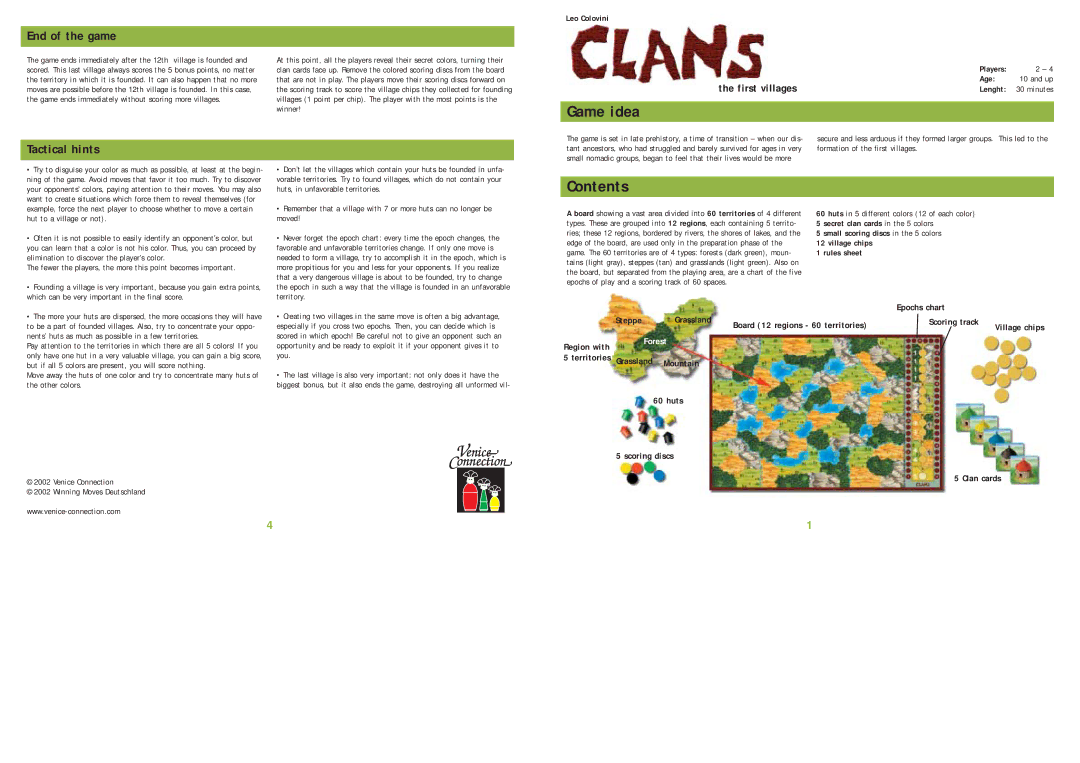
End of the game
The game ends immediately after the 12th village is founded and scored. This last village always scores the 5 bonus points, no matter the territory in which it is founded. It can also happen that no more moves are possible before the 12th village is founded. In this case, the game ends immediately without scoring more villages.
At this point, all the players reveal their secret colors, turning their clan cards face up. Remove the colored scoring discs from the board that are not in play. The players move their scoring discs forward on the scoring track to score the village chips they collected for founding villages (1 point per chip). The player with the most points is the winner!
Leo Colovini
| Players: | 2 – 4 |
the first villages | Age: | 10 and up |
Lenght: | 30 minutes |
Game idea
Tactical hints
The game is set in late prehistory, a time of transition – when our dis- | secure and less arduous if they formed larger groups. This led to the |
tant ancestors, who had struggled and barely survived for ages in very | formation of the first villages. |
small nomadic groups, began to feel that their lives would be more |
|
•Try to disguise your color as much as possible, at least at the begin- ning of the game. Avoid moves that favor it too much. Try to discover your opponents’ colors, paying attention to their moves. You may also want to create situations which force them to reveal themselves (for example, force the next player to choose whether to move a certain hut to a village or not).
•Often it is not possible to easily identify an opponent’s color, but you can learn that a color is not his color. Thus, you can proceed by elimination to discover the player’s color.
The fewer the players, the more this point becomes important.
•Founding a village is very important, because you gain extra points, which can be very important in the final score.
•The more your huts are dispersed, the more occasions they will have to be a part of founded villages. Also, try to concentrate your oppo- nents’ huts as much as possible in a few territories.
Pay attention to the territories in which there are all 5 colors! If you only have one hut in a very valuable village, you can gain a big score, but if all 5 colors are present, you will score nothing.
Move away the huts of one color and try to concentrate many huts of the other colors.
© 2002 Venice Connection
© 2002 Winning Moves Deutschland
•Don’t let the villages which contain your huts be founded in unfa- vorable territories. Try to found villages, which do not contain your huts, in unfavorable territories.
•Remember that a village with 7 or more huts can no longer be moved!
•Never forget the epoch chart: every time the epoch changes, the favorable and unfavorable territories change. If only one move is needed to form a village, try to accomplish it in the epoch, which is more propitious for you and less for your opponents. If you realize that a very dangerous village is about to be founded, try to change the epoch in such a way that the village is founded in an unfavorable territory.
•Creating two villages in the same move is often a big advantage, especially if you cross two epochs. Then, you can decide which is scored in which epoch! Be careful not to give an opponent such an opportunity and be ready to exploit it if your opponent gives it to you.
•The last village is also very important: not only does it have the biggest bonus, but it also ends the game, destroying all unformed vil-
4
Contents
A board showing a vast area divided into 60 territories of 4 different | 60 huts in 5 different colors (12 of each color) |
| |||||
types. These are grouped into 12 regions, each containing 5 territo- | 5 secret clan cards in the 5 colors |
| |||||
ries; these 12 regions, bordered by rivers, the shores of lakes, and the | 5 small scoring discs in the 5 colors |
| |||||
edge of the board, are used only in the preparation phase of the | 12 village chips |
|
|
| |||
game. The 60 territories are of 4 types: forests (dark green), moun- | 1 rules sheet |
|
|
| |||
tains (light gray), steppes (tan) and grasslands (light green). Also on |
|
|
|
| |||
the board, but separated from the playing area, are a chart of the five |
|
|
|
| |||
epochs of play and a scoring track of 60 spaces. |
|
|
|
|
| ||
|
|
|
|
|
|
|
|
|
|
|
|
| Epochs chart |
| |
| Steppe | Grassland |
|
|
| track |
|
| Board (12 regions - 60 territories) | Scoring |
| ||||
| Village chips | ||||||
|
|
|
|
| |||
Region with | Forest |
|
|
|
|
| |
|
|
|
|
| |||
|
|
|
|
|
|
| |
5 territories Grassland | Mountain |
|
|
|
|
| |
60huts
5 scoring discs
5 Clan cards
1
